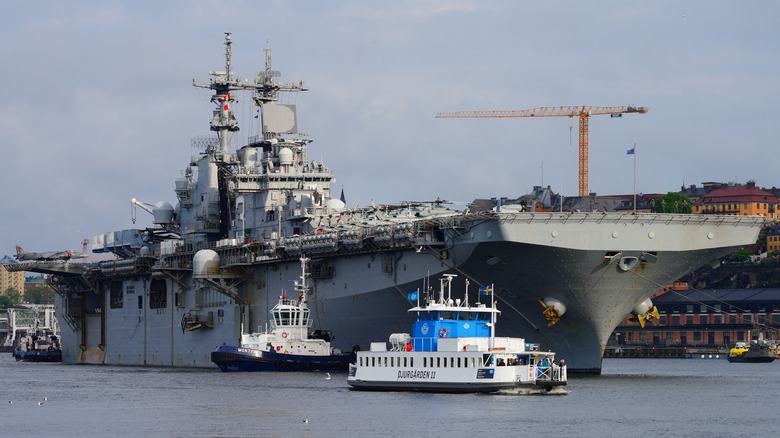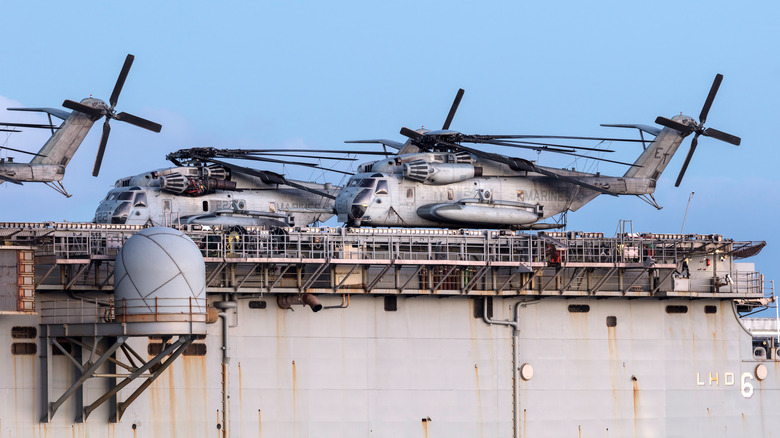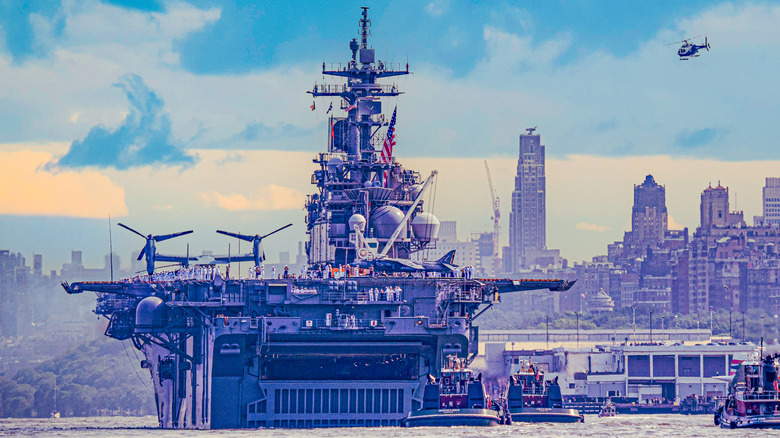What Is A Helicopter Carrier And What Makes It Different From An Aircraft Carrier?
While most people are aware of what an aircraft carrier is from movies, seeing them in person, or serving aboard them, there's another similar craft many are unfamiliar with. The helicopter carrier is a much smaller type of aircraft carrier that doesn't typically carry jets unless they have vertical take-off and landing (VTOL) capabilities, like the Harrier. Indeed, several helicopter carriers do carry aircraft capable of VTOL or short take-off and vertical landing (STOVL).
A helicopter carrier is, as the name implies, a vessel that carries helicopters. Or at least, that's how they were initially used. It's a fairly simple design and is used primarily by navies for support and combat missions. The United States classifies them as light aircraft carriers and includes the Wasp class of amphibious assault ships used primarily by the United States Marine Corps.
While helicopter carriers aren't commonly known, they are vital in support operations, where helicopters are needed for everything from air assault missions to close air support. Helicopter carriers have evolved over the years as aircraft technology has advanced. This has made the helicopter carrier one of the most important ships in the fleet, and numerous nations operate them, including the People's Republic of China, Japan, Australia, and many more.
How a helicopter carrier compares to an aircraft carrier
Helicopter carriers are much smaller than traditional aircraft carriers. For example, the newest model carrier employed by the U.S. Navy, the Gerald R. Ford-class carrier, weighs around 100,000 lbs., making it the largest combat vessel ever built. Wasp-class helicopter carriers typically weigh in at around 40,500 lbs., depending on the number of aircraft they carry. Despite their smaller size, helicopter carriers offer an important advantage over a typical aircraft carrier.
Helicopter carriers require far fewer personnel on board and can deploy a force of 2,000 Marines anywhere in the world. An aircraft carrier often has five times the number of people aboard, depending on its operational status. In addition to accommodating STOVL fixed-wing aircraft and helicopters, Wasp-class carriers support Landing Craft Air Cushion (LCAC) hovercraft, so it has diverse operational support capabilities. Of course, a standard carrier can and does support helicopters and STOVL fixed-wing aircraft, but it's not designed for that purpose — at least, it's not an aircraft carrier's primary mission.
Because of their smaller size, Wasp-class helicopter carriers can move into tighter areas, reaching locations a typical carrier cannot. Helicopter carriers are also used for amphibious assault operations using a variety of amphibious assault vehicles and landing craft carried by Wasp-class carriers. There are other classes and many nations have their own helicopter carriers in service, but they all function in much the same way.
The kinds of operations a helicopter carrier supports
There are several operations a helicopter carrier can support, and they've been used by various navies throughout their operational history. In the United States, helicopter carriers of various classes have taken part in all kinds of operations, including seaborne assault, electronic warfare, search and rescue, and anti-submarine warfare. Helicopters are incredibly useful in finding enemy submarines, making these carriers vital in that scope.
Helicopter carriers aren't part of a traditional aircraft carrier battle group and can operate independently for extended periods. Their aircraft can perform anything from air interdiction to deep strikes within enemy territory. The USS Wasp (LHD 1) has been involved in numerous operations since its introduction as the first Wasp-class multipurpose amphibious assault ship.
After first setting sail in December 1991, the Wasp took part in Operation Restore/Continue Hope off the Somali coast. After that, it worked drug interdiction operations in the Caribbean, and it supported NATO exercises in support of Operations Support and Uphold Democracy. It was later used to conduct combat operations in Afghanistan, and it also supported rescue and recovery operations following tumultuous hurricanes. There aren't many missions a helicopter carrier can't support, making it one of the most useful vessels in the fleet.


